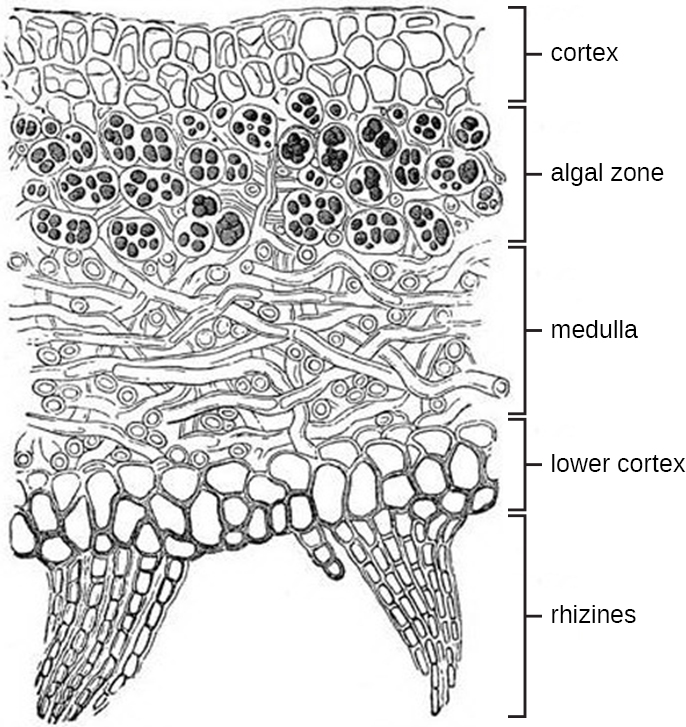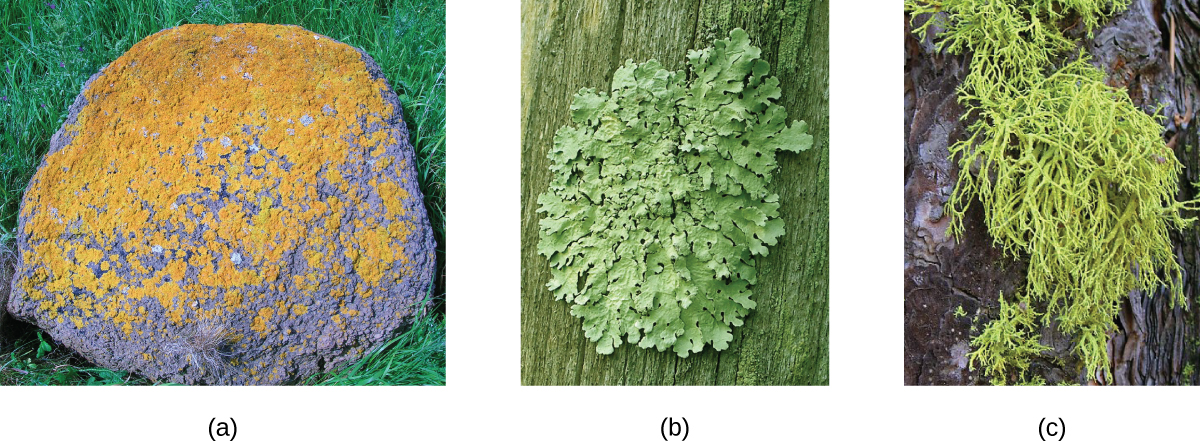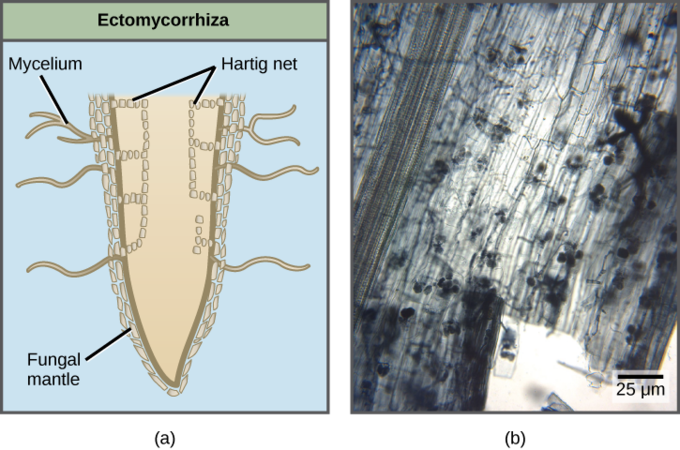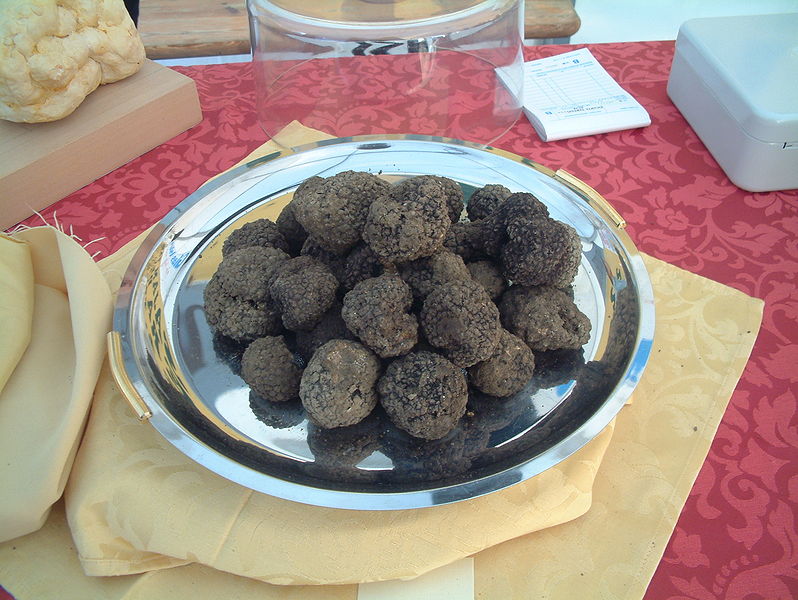10. Microbial Ecology and Applied Microbiology
10.2 Microbial Symbioses: Lichens and Mycorrhizae
Learning Objectives
- Explain why lichens and mycorrhizae are included in the study of microbiology
- Describe the unique characteristics of lichens and mycorrhizae, and the role of each partner in the symbiotic relationship
- Describe ways in which lichens and mycorrhizae are beneficial to the environment
Symbiosis is the ecological interaction between two organisms that live together. However, the definition does not describe the quality of the interaction. When both members of the association benefit, the symbiotic relationship is called mutualistic. Fungi form mutualistic associations with many types of organisms, including cyanobacteria, plants, and animals. Lichens and mycorrhizae are two well-known examples and are both important components of most terrestrial ecosystems. Lichens contribute to soil production by breaking down rock, and they are early colonizers in soilless environments such as lava flows. The cyanobacteria in some lichens can fix nitrogen and act as a nitrogen source in some environments. Lichens are also important soil stabilizers in some desert environments and they are an important winter food source for caribou and reindeer. Finally, lichens produce compounds that have antibacterial effects, and further research may discover compounds that are medically useful to humans. Mycorrhiza, which comes from the Greek words “myco” meaning fungus and “rhizo” meaning root, refers to the association between vascular plant roots and their symbiotic fungi. About 80 percent of all plant species have mycorrhizal partners. In a mycorrhizal association, the fungal mycelia use their extensive network of hyphae and large surface area in contact with the soil to channel water and minerals from the soil into the plant, thereby increasing a plant’s nutrient uptake. In exchange, the plant supplies the products of photosynthesis to fuel the metabolism of the fungus.
Characteristics of Lichens
Lichens are characterized as species, and look much like plants, but they are in fact a combination of two or sometimes 3 organisms: 1-2 photosynthetic microbial species and a fungal partner. The photobiont is normally a green alga, but may also be cyanobacterium, and the fungal partner or mycobiont, is an ascomycete or basidiomycete fungus. Together these microbes live in a symbiotic partnership and expanding the environments in which the photobiont may grow: on their own, algae and cyanobacteria normally grow only in aquatic or extremely moist environments. Lichens, in contrast, can potentially be found on almost any surface (especially rocks) or as epiphytes (meaning that they grow on other plants).
In some ways, the symbiotic relationship between lichens and algae seems like a mutualism (a relationship in which both organisms benefit). The fungus can obtain organic nutrients from the photosynthetic algae or cyanobacterium and the algae or cyanobacterium can grow in a drier environment than it could otherwise tolerate. However, most scientists consider this symbiotic relationship to be a controlled parasitism (a relationship in which one organism benefits and the other is harmed) because the photosynthetic organism grows less well than it would without the fungus. It is important to note that such symbiotic interactions fall along a continuum between conflict and cooperation.
Lichens are slow growing and can live for centuries. They have been used in foods and to extract chemicals as dyes or antimicrobial substances. Some are very sensitive to pollution and have been used as environmental indicators.
Lichens have a body called a thallus, an outer, tightly packed fungal layer called a cortex, and an inner, loosely packed fungal layer called a medulla (Figure 10.8). Lichens use hyphal bundles called rhizines to attach to the substrate.

Lichen Diversity
Lichens are classified as species – they can also be grouped into types based on their morphology. There are three major types of lichens, although other types also exist. Lichens that are tightly attached to the substrate, giving them a crusty appearance, are called crustose lichens. Those that have leaf-like lobes are foliose lichens; they may only be attached at one point in the growth form, and they also have a second cortex below the medulla. Finally, fruticose lichens have rounded structures and an overall branched appearance. Figure 10.9 shows an example of each of the forms of lichens.

- What types of organisms are found in lichens?
- Why is the relationship considered controlled parasitism?
- What is the ecological relevance of lichens?
Characteristics of Mycorrhizae
There are a number of types of mycorrhizae, however the two most important are the ectomycorrhizae and the endomycorrhizae. Ectomycorrhizae (“outside” mycorrhizae) are characterized by fungal growth that envelops, but does not penetrate, the root cells. The fungal growth forms a sheath (called a mantle) and a Hartig net of hyphae extends into the intercellular spaces between root cells, establishing extensive contact with the root cells (Figure 10.10). The fungal partner can belong to the Ascomycota, Basidiomycota, or Zygomycota. In this mutualistic relationship, the fungi are not saprophytic – the plant provides the fungi with organic carbon, and the fungal partner provides nutrients, in particular, phosphorus and nitrogen, as well as water. The network of fungal mycelia may extend well beyond the plant’s rhizosphere, effectively expanding the root’s ability to absorb nutrients and water from surrounding soils.
In a second type, the Glomeromycete fungi form vesicular–arbuscular mycorrhizae or endomycorrhizae. In these mycorrhizae, the fungal hyphae penetrate the walls of the root cells, and cause invagination of the plasma membrane (Figure 10.10). They do not, however, breach the plasma membrane of the root cells. The arbuscules (from the Latin for “little trees”) have a shrub-like appearance. This is also a mutualistic relationship, with the same benefits derived by both partners as in the ectomycorrhizae. In addition, however, the Glomeromycete partner may provide protection against nematodes and other pests.

The orchidaceous mycorrhizae form between orchids and a fungal partner, usually a Basidiomycete. Orchids are epiphytes that form small seeds without much storage to sustain germination and growth. Their seeds will not germinate without a mycorrhizal partner. After nutrients in the seed are depleted, fungal symbionts support the growth of the orchid by providing the necessary carbohydrates and minerals. Some orchids produce chloroplasts only after passing the seedling stage. Others never produce chloroplasts and continue to be mycorrhizal throughout their lifecycle. In contrast to the ectomycorrhizae and arbuscular mycorrhizae, this is not a mutualistic relationship but a parasitic one. The fungal partner is saprophytic and as such, can grow on its own. The orchid is therefore a parasite.
Edible Mycorrhizae
The most expensive mushrooms in the world are the product of mycorrhizal fungi: truffles (Figure 10.11), chanterelles, porcini mushrooms and morels. The cost for these delicacies is related to their highly complex life cycles, which have proven difficult, and in some cases, impossible to replicate. Thus, for some species, commercial production is not possible and trying to overcome this problem is an active area of research.

- How do plants benefit from an association with mycorrhizal fungi?
- Given the fact they penetrate plant root cell walls, why are endomycorrhizae considered mutualists, rather than parasites?
- What are some of the edible fruiting bodies of mycorrhizal fungi and why are some so expensive?
Key Takeaways
- Lichens are a symbiotic association between a fungus and an alga or a cyanobacterium. Despite being based on a symbiotic association between two different species, in some cases, from two different domains, lichens are subdivided themselves into species.
- The symbiotic association found in lichens is currently considered to be a controlled parasitism, in which the fungus benefits and the alga or cyanobacterium is harmed
- Lichens are slow growing and can live for centuries in a variety of habitats. They are environmentally important, helping to create soil, providing food, and acting as indicators of air pollution
- Most mycorrhiza are formed from a mutualistic association between plant roots and certain types of multicellular fungi. The fungal mycelia effectively extends the plant root system, and therefore the plant’s access to nutrients and water; in return, the plant supplies the fungi with photosynthesis products for their metabolic use.
- Orchids also form mycorrhizal relationships but because the orchid benefits at the expense of its fungal partner, this is considered a parasitic relationship.
- The fruiting bodies or mushrooms of some mycorrhizae are considered delicacies. These include truffles, chanterelles, morels and porcini mushrooms. Because their life cycles are so complex, commercial cultivation is not always possible and the relative costs reflect their rarity.
Multiple Choice
Critical thinking
- Compare and contrast lichens with mycorrhizae.
Media Attributions
- Basic CMYK
- OSC_Microbio_05_05_lichens
- Mycorrhyzae
- Truffles_black_Croatia

